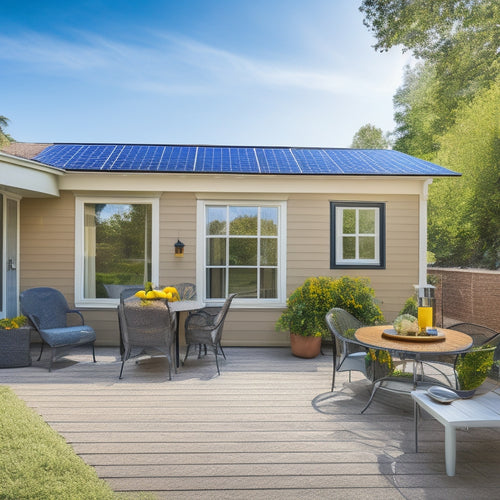
Annual Maintenance Costs for Homeowners' Peace of Mind
Share
You invested a significant amount in your home, so it's crucial to budget for annual maintenance costs to guarantee your peace of mind. Expect to pay around $400 to $1,000 for solar panel maintenance, $200 to $500 for roof inspections, and $100 to $500 for HVAC tune-ups. Plumbing system check-ups, pest control, and gutter cleaning will add to your expenses. Appliance upkeep and lawn care will also require some budgeting. By understanding these costs, you'll be better prepared to protect your investment and avoid costly surprises. Now, take the next step to learn how to prioritize your maintenance budget effectively.
Key Takeaways
• Annual solar panel maintenance costs $400 to $1,000, increasing efficiency by up to 20% and saving thousands in energy costs.
• Regular HVAC maintenance extends system lifespan, saves on energy bills, and prevents costly repairs, with annual tune-ups costing around $100 to $300.
• Neglecting plumbing maintenance can lead to costly repairs, while regular inspections and fixes can save up to 10% on water bills and prevent water damage.
• Routine gutter cleaning and maintenance can prevent water-related issues, foundation damage, and costly repairs, with annual costs ranging from $100 to $300.
• Pest control and extermination services, including routine inspections and treatments, can cost $100 to $500 annually, preventing property damage and health risks.
Average Cost of Solar Panel Maintenance
On average, you can expect to pay around $400 to $1,000 per year for routine solar panel maintenance, depending on the size of your system and the frequency of inspections. This might seem like a significant expense, but trust us, it's worth it. Regular upkeep guarantees your solar panels operate at peak efficiency, maximizing your energy savings. Think of it as an investment in your energy independence!
In fact, a well-maintained solar panel system can increase its efficiency by up to 20%! That's like getting free energy, just for taking care of your panels. And let's not forget about the long-term benefits: a clean and well-maintained system can last up to 30 years or more, saving you thousands in energy costs over time.
Roof Inspection and Repair Costs
As you're enjoying the energy savings from your solar panels, it's equally important to keep an eye on the roof that supports them, since a damaged or worn-out roof can compromise the entire system, leading to costly repairs down the line.
You don't want to be stuck with a hefty bill because you overlooked a few loose shingles or curled roof tiles. Regular roof inspections can help identify potential issues before they escalate into major problems.
The average cost of a roof inspection is around $200 to $500, depending on the size and complexity of your roof.
Keep in mind that roof age plays a significant role in determining the frequency and cost of repairs. If your roof is nearing the end of its lifespan (typically 20 to 30 years), you may need to budget for more frequent inspections and repairs.
Additionally, if you live in an area prone to storm damage, you may need to factor in extra costs for repairs and replacements. A routine inspection can help you stay ahead of the game and avoid costly surprises down the line.
HVAC Maintenance and Tune-Ups
You'll want to make sure your heating, ventilation, and air conditioning (HVAC) system is running efficiently to complement your energy-saving solar panels, and regular maintenance is key to avoiding costly repairs and breakdowns.
A well-maintained HVAC system not only saves you money on energy bills but also extends its lifespan. Start by changing the air filter every 1-3 months to guarantee optimal system efficiency. A dirty air filter can increase your energy bills and even cause your system to fail prematurely.
Next, schedule a professional tune-up annually to inspect and clean the condenser coils, check refrigerant levels, and ensure proper airflow. This will help prevent mid-summer breakdowns and keep your home comfortable all year round.
Don't wait until it's too late – invest in regular HVAC maintenance to enjoy peace of mind and a healthy bank account. By doing so, you'll be breathing easy, literally and figuratively!
Plumbing System Check-Ups
By inspecting your plumbing system regularly, you can catch leaks, clogs, and corrosion before they cause catastrophic damage, saving you from costly repairs and messy cleanups. Think of it as a health check-up for your pipes!
A thorough plumbing system check-up can detect hidden issues, like slow leaks that waste water and drive up your utility bills. In fact, according to the EPA, fixing leaky faucets and toilets can save homeowners up to 10% on their water bills. That's some serious water conservation!
When you schedule regular check-ups, you'll also avoid those dreaded midnight emergency calls to the plumber, which can be a real budget-buster. And let's not forget about the peace of mind that comes with knowing your plumbing system is in top shape.
Pest Control and Extermination Fees
As a homeowner, you're likely no stranger to the unwanted visitors that can invade your space - from pesky ants to unwelcome rodents.
When dealing with pest control and extermination fees, understanding the types of pest infestations you might face, the common methods used to tackle them, and the costs associated with these services is crucial.
Types of Pest Infestations
Dealing with pest infestations is an unfortunate reality for many homeowners, with common culprits including termites, ants, rodents, and bed bugs that can cause significant property damage and health risks if left unchecked. You might be wondering, what kind of pests can you expect to encounter?
| Pest Type | Common Issues |
|---|---|
| Termites | Structural damage to wood, weakening of beams and foundations |
| Rodents | Rodent habitats in walls, attics, and basements, spreading diseases and contaminating food |
| Ants | Insect bites, food contamination, and property damage from nesting |
| Bed Bugs | Itchy bites, allergic reactions, and emotional distress |
As a homeowner, it's essential to recognize the signs of an infestation and take prompt action to prevent further damage. Rodent habitats, for instance, can lead to electrical fires and property damage. Meanwhile, insect bites from ants and bed bugs can cause discomfort, allergic reactions, and even emotional distress. Stay vigilant, and don't let pests take over your home!
Common Pest Control Methods
Understanding the various options and their associated costs is crucial for making an informed decision when choosing a pest control method that suits your situation.
When it comes to common pest control methods, you've got a range of choices - and we're not just talking about calling in the pros (although, let's be real, sometimes that's the best option).
Natural deterrents, like essential oils and ultrasonic devices, can be an effective and eco-friendly way to keep pests at bay. Organic solutions, such as diatomaceous earth and boric acid, offer a non-toxic alternative to chemical-based pesticides.
And then, of course, there are the DIY enthusiasts who swear by homemade remedies like cinnamon and cayenne pepper to keep ants and roaches away.
Whatever your approach, weighing the costs and benefits of each method is crucial to finding what works best for you and your wallet. After all, peace of mind is priceless - but it's also nice to know what you're paying for.
Cost of Extermination Services
Your wallet will take a hit when you call in the pros, with extermination services ranging from a few hundred to several thousand dollars, depending on the type and severity of the infestation. Don't be surprised if you're quoted a higher price for emergency services or complex jobs, like wildlife removal.
Pest prevention measures, on the other hand, can be more budget-friendly, with routine inspections and treatments costing anywhere from $100 to $500 annually. Keep in mind that these costs can add up quickly, especially if you're dealing with a severe infestation or recurring issues.
To avoid breaking the bank, consider investing in preventative measures, like sealing entry points and keeping your home clean. By being proactive, you can reduce the likelihood of needing costly extermination services in the first place.
Gutter Cleaning and Replacement
Clogged gutters overflowing with debris can wreak havoc on your home's foundation, so it's important to prioritize regular gutter cleaning and replacement to prevent costly repairs down the line. You don't want to be stuck with a hefty bill for water damage or foundation repairs because you neglected your gutters. Regular cleaning and maintenance can save you from these headaches.
Here are some reasons why you should take gutter maintenance seriously:
-
Water damage: Clogged gutters can cause water to seep into your home, damaging walls, ceilings, and floors.
-
Foundation issues: Overflowing gutters can erode your home's foundation, leading to costly repairs or even collapse.
-
Pest infestations: Debris-filled gutters are a breeding ground for pests like mosquitoes, rodents, and birds.
- Gutter damage: Failing to clean your gutters can lead to rust, corrosion, and eventual replacement – a costly expense you can avoid with regular maintenance.
Consider investing in gutter guards to reduce maintenance and downspout extensions to make sure water flows away from your home. By staying on top of gutter cleaning and replacement, you'll enjoy peace of mind and a protected home.
Appliance Maintenance and Upkeep
Regularly inspecting and maintaining your appliances can help prevent costly repairs, reduce energy bills, and even avoid safety hazards. You don't want to be stuck with a broken fridge in the middle of summer, or worse, a faulty oven that sets off your fire alarm. By keeping your appliances in top shape, you'll not only save money on repairs but also extend their lifespan.
For instance, cleaning your oven regularly can enhance its energy efficiency and prevent food residue from building up. Similarly, replacing your dishwasher's filter every few months can guarantee it runs smoothly and efficiently.
Don't forget to check your refrigerator's seals and replace them if necessary – a tight seal can make a big difference in your energy bills. By staying on top of these small tasks, you'll be rewarded with appliances that run like clockwork, use less energy, and last longer.
Lawn Care and Landscaping Costs
As a homeowner, you know that maintaining your lawn and landscape is essential to your property's curb appeal and overall value.
You're probably wondering what it'll cost you to keep your outdoor space looking its best.
Let's break down the expenses involved in lawn care and landscaping, from mowing frequency to yard waste disposal and hedge trimming costs.
Lawn Mowing Frequency
On average, you'll need to mow your lawn every 7-10 days during the growing season to maintain a neat and tidy appearance. This frequency guarantees your lawn looks lush and healthy, enhancing your home's curb appeal. A well-manicured lawn isn't only aesthetically pleasing, but it also increases your property value.
Here are some things to keep in mind when creating your mowing schedule:
-
A consistent mowing schedule helps prevent weeds from taking over your lawn.
-
Mowing at the right height (2.5-3 inches) promotes healthy growth and reduces the need for frequent watering.
-
Don't forget to edge and trim those hard-to-reach areas to maintain a polished look.
- A well-maintained lawn is a great way to make a good first impression on guests and potential buyers if you're selling your home.
Yard Waste Disposal
You'll need to factor in yard waste disposal, a critical aspect of lawn care and landscaping costs that can add up quickly if not managed efficiently. As a homeowner, it's crucial to take into account the costs of disposing of leaves, branches, and other organic materials that accumulate on your property.
One way to reduce these costs is by adopting a composting routine, which not only saves you money but also has numerous environmental benefits. Composting helps reduce waste, creates nutrient-rich soil, and even supports a healthier lawn. By composting, you'll lessen the amount of waste sent to landfills, decreasing the environmental impact of your yard maintenance.
Additionally, composting can lower your waste disposal costs by up to 30%! By implementing a composting routine, you'll not only save money but also contribute to a more sustainable future. So, start composting today and watch your yard waste disposal costs shrink while doing your part for the environment.
Hedge Trimming Costs
Maintaining neatly trimmed hedges is essential to your lawn's overall appearance, and this task comes with a price tag that can vary depending on the size, type, and frequency of trimming. As a homeowner, you want to keep your hedges looking their best, but you might be wondering how much it'll cost you.
Here are some factors that can affect your hedge trimming costs:
-
The size and number of hedges: The bigger and more hedges you have, the more you'll pay for trimming.
-
Hedge shapes: Fancy shapes like topiaries or animal shapes require more skill and time, increasing the cost.
-
Trimming tools: Using gas-powered trimmers or hiring a pro with high-end equipment can drive up costs.
- Frequency of trimming: Trimming more frequently means more frequent payments.
Frequently Asked Questions
What Is the Ideal Frequency for Inspecting and Cleaning Dryer Vents?
You should inspect and clean your dryer vents every 6-12 months to guarantee dryer efficiency and vent safety - it's an essential step to prevent fires and save energy, so don't slack on this vital task!
Are Homeowners Responsible for Maintaining Neighborhood Sidewalks?
You're wondering who's on the hook for sidewalk maintenance? Typically, it's a municipal obligation, but in some cases, homeowners might be liable for sidewalk repairs. Check your local ordinances to avoid any sidewalk liability surprises!
How Often Should Fire Extinguishers Be Inspected and Replaced?
You're on top of fire safety! Inspect your fire extinguishers monthly, ensuring they're easily accessible and fully charged. Replace them every 6-12 years, depending on the type - water, foam, dry chemical, or carbon dioxide - and always follow local regulations.
What Is the Recommended Schedule for Inspecting and Replacing Smoke Detectors?
You should inspect your smoke detectors monthly, testing batteries and confirming interconnectivity between devices; replace them every 10 years or according to the manufacturer's instructions to guarantee your safety and peace of mind.
Can Homeowners Claim Maintenance Costs on Their Tax Returns?
You're wondering if you can write off those smoke detector replacements on your taxes? Yes, you can claim maintenance costs as tax deductions, but you'll need to track those expenses carefully to cash in on the savings!
Related Posts
-

10 Tips to Buy Affordable Solar Panels Online
When purchasing affordable solar panels online, you'll want to research reputable retailers, compare prices, and chec...
-

Master Advanced Solar Panel Design Online for Free
You can master advanced solar panel design online for free by leveraging specialized courses and training platforms, ...
-

Eco-Friendly Car Battery Solutions Available Online
You can now shop online for eco-friendly car battery solutions that not only reduce your carbon footprint but also of...


